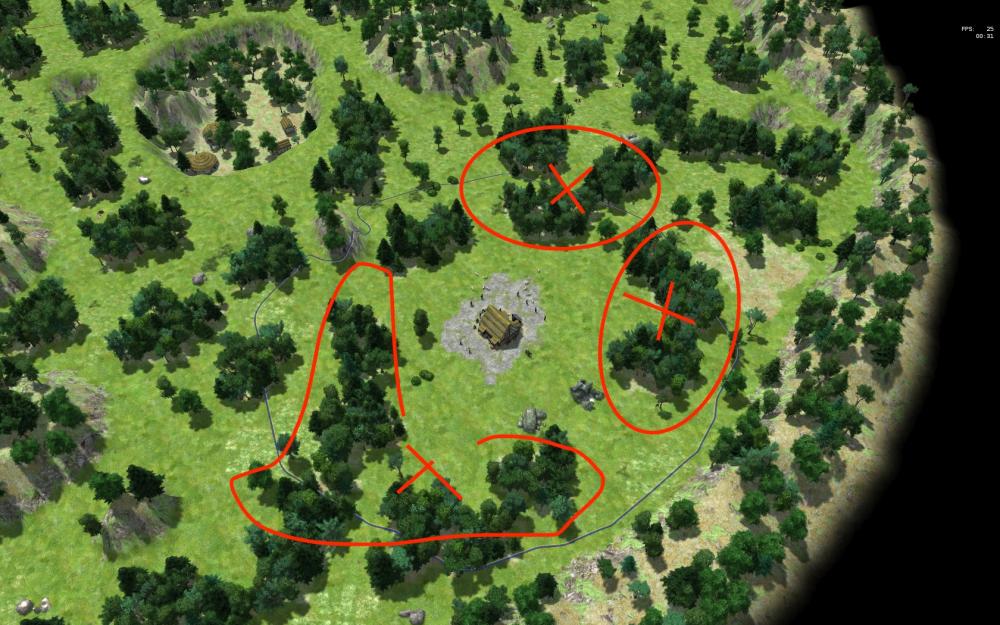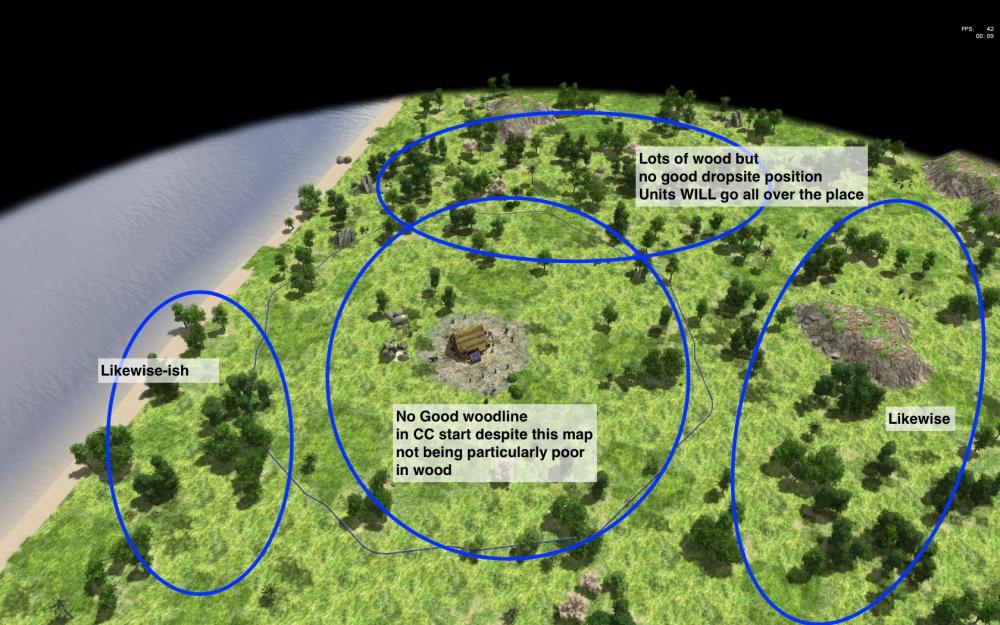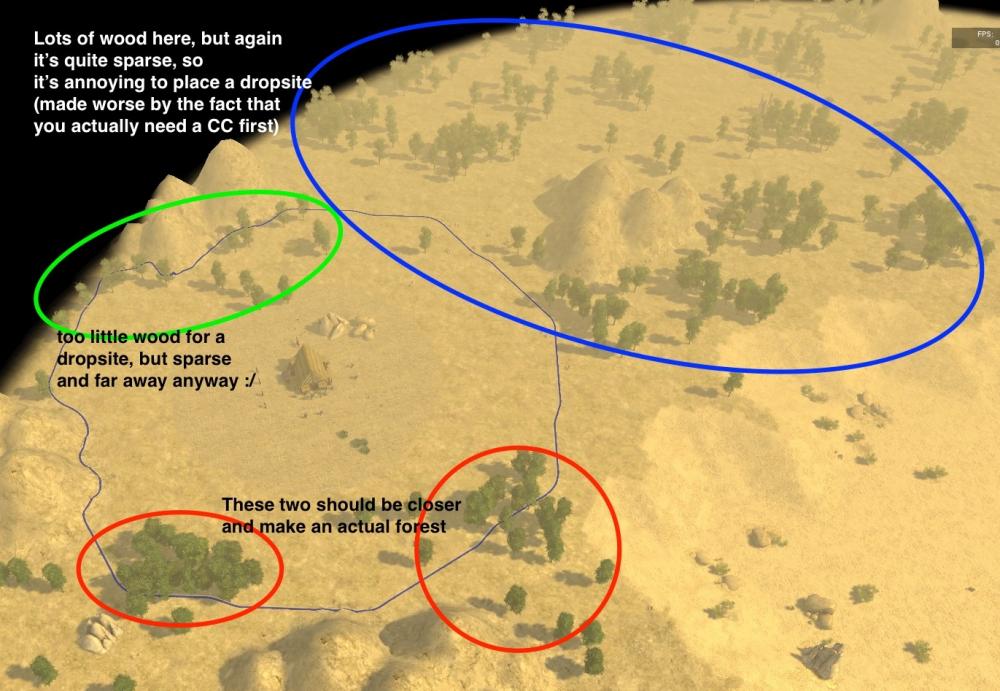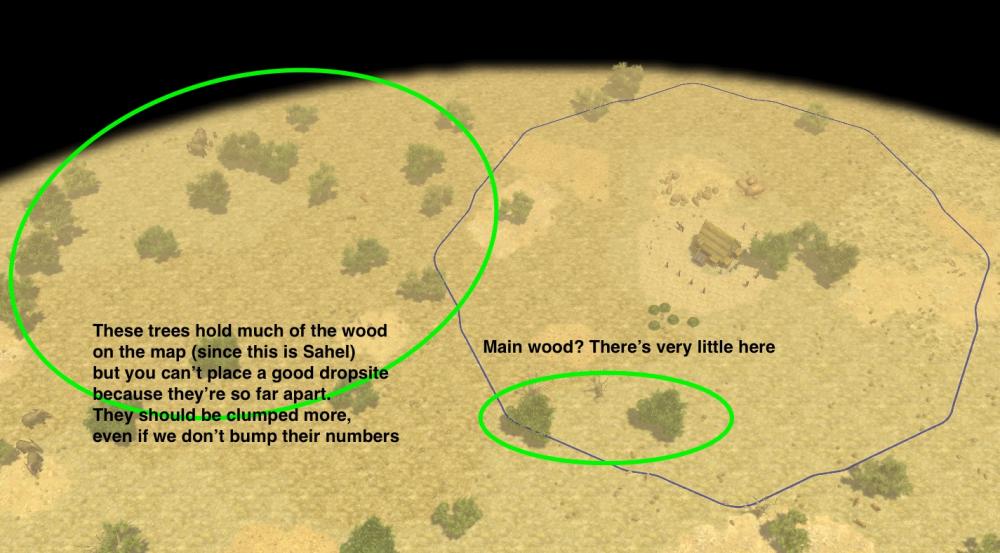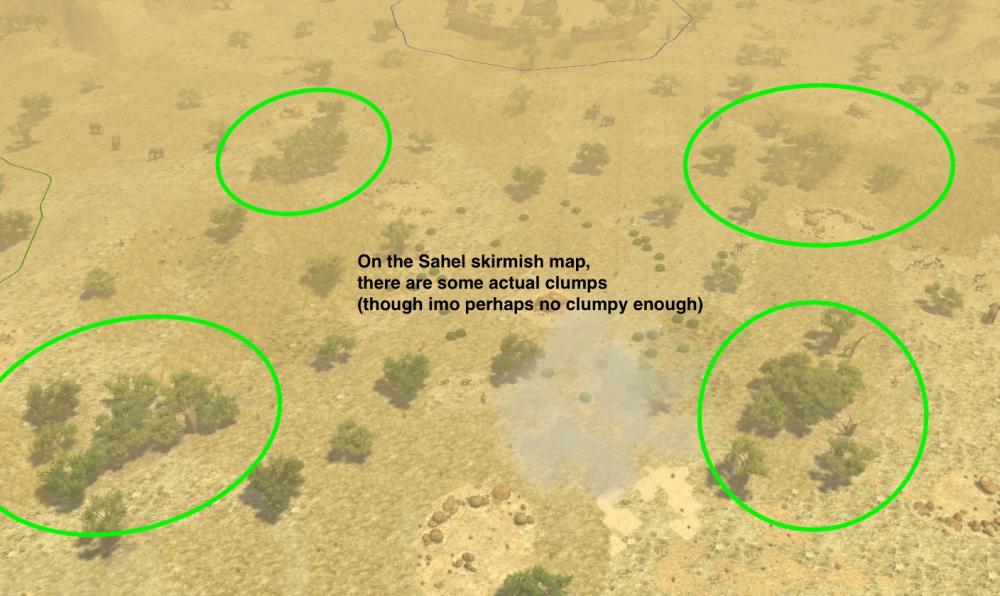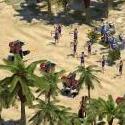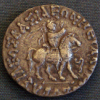Leaderboard
Popular Content
Showing content with the highest reputation on 2017-03-23 in all areas
-
Disclaimer: This was done on one night, based heavily on one person’s comment, from one small voice (me) who is a peasant exercising his right on free speech. Quote in the "Resource System & Map control Elements" Following on @Wesley's comment, I went and tried to trace back the original intention of the Citizen Soldier up to the state they are currently in (not with research, but with assumptions, so go ahead and fault me for that). Now if 0 A.D.’s thesis in the Starting Game is “Make each Faction immediately recognizable”, then I believe they are successful in that. If I chose “Random” before we start, then I can immediately tell what Faction I’m controlling just by looking at the Civic Center and the units I have without looking at the Emblem at the center top part of the UI. This is where 0 A.D. improves over AoE2. Now, the Citizen Soldiers have inherited that aspect. Although they’re being mocked as “Soldiers who can gather”, they’re actually “Villagers who can fight” (Yes I’ll be relying on "'living' is not the same as 'not dying'" logic). If you’re complaining that you’d rather gather with these guys, then you shouldn't since they were intended to do that. It's players like me who are the ones using them in an un-orthodox manner (sending them to war). The reason why we have Champion Spams back then is that it is the original intention of the game: Gather with Citizen Soldiers, then send the Champions to war. But then, some things happened over the years: Horsemen have become a lot faster (they were nearly as fast as walking soldiers back then). Champion (Pure Military) Units have increased their train time. Citizen Soldiers received some rebalancing of stats. What all this all means is that the Citizen Soldiers have taken center stage both in the Economy and Military side of things. And, you know what? This further led me to recognize what @DarcReaver has been actively harping over the forums recently: Citizen Soldiers broke the game. 1. You can’t Distinguish between Economic and Military Units New players shouldn’t be going “Oh, my soldiers can gather and build. That’s cool!”. They should’ve been going “Oh, my villagers can defend themselves. That’s cool!” They don’t see Citizen Soldiers as Economic Units with Fighting as an add-on, they identify them as Military Units with Gather/Build as the add-on. The reason why we see @drsingh complaining about the Civic Center being able to train Military Units is that he doesn’t see the Citizen Soldiers as Economic Units. And judging from the game’s current state his complaint has become valid. 2. Lack of Military Unit Diversity And here's another problem, guys. If you’re wondering why we don’t have enough diversity in Champions or any Pure Military Units for that matter, then the reason is that most of the units went into the Citizen Soldier category. This must be the reason why I feel that Phase 2 is the emptiest phase in the game. You’re not presented with more military, you're presented with more gatherers. Here’s another thing. The elephant is a Soldier-type unit for whatever reason. But looking at a certain unit progression. I believe the original intention was this: Phase 1 – Citizen Soldiers + Women Phase 2 – Soldiers Phase 3 – Champions + Heroes That’s one way I can make sense for why there is a soldier-type unit. Now with all that in mind, I think we should not remove the gathering ability of the Citizen Soldiers since that was the original intention. Rather, something must be done with the military strength they obtained over the years. I think they should be nerfed. Rush Cavs (as much as I personally like to have that strategy available) should not be possible. Cavs should either lose their gathering capabilities, or they are not available in the Civic Center. A little harassment here and there can still be a staple in the early game, but rushes might not be good for a game that has city-building also in mind. Make Town Phase more relevant by putting the Town Phase Units from Citizen Soldiers to Soldier category. Yes, I know this post has come to a set of suggestions, but I believe this was the original gameflow of 0 A.D. Only that much of the playerbase has dictated to where it is now. Now, go. Tear down my arguments. I was just here to ramble.5 points
-
3 points
-
Now that the bug has been confirmed, maybe also post an announcement on the Transifex project? Translators might not even be aware of losing their work. One does not always test immediately, so I was lucky that I caught it pretty quick.3 points
-
The simple truth is people just like to compare video games to one another. Breath of the Wild is like Horizon zero dawn, which is similar to Witcher 3, which itself is like Skyrim, which is... a clone of Pac-Man. I've seen many of these 0 A.D. comparisons made on Youtube (and elsewhere) since I joined the team 7 years ago, and to be honest it's often an honor for us to be compared to some of the greats in the historic RTS gaming genre3 points
-
Resource & economy System revised This concept only covers economic features of civs. Military will be covered in a separate topic to keep this thing small. Some aspects of economy of course affect military as you’ll see later, but this is not the main argument at the moment. Military design and economic design will be tweaked to fit each other for every civ type. At first: I’d suggest to pair civilizations into groups (i.e. Hellenic Civs, Nordic civs, Indian/African civs and so on). I’ve covered Gauls, Britons, Iberians, Spartans, Athenians and Seleucids so far as more-or-less specific layouts. This again is not a 100% finished layout with every detail covered. Instead it's a general guideline to differ civs from each other and allow to create unique game play patterns for each of them. More than they currently are. The other civs will come later as I need to create something unique for them aswell. I’ll expand this concept for them in the next update(s). A .pdf is attached to be bottom of this post. (edit: I rewrote some parts because they contained some spelling errors. Should be more readable now) I. General thoughts on resources Every strategy game requires resources. The resources have to fit the game and players should have a choice whether collecting which resource is more important to them (strategic diversity). Each resource needs to fulfil a certain “role” that gathering it accomplishes it. To prevent “overburdening” the game with resources there has to be a flow in the game to naturally lead players towards gathering new resources (i.e. a progression from resource A into resource A+B into resource B etc.). Resources that already are gathered by players may not become redundant (because it’s replaced by another resource). If this is done well the economy management doesn’t become boring or unhealthy for the game and allows interesting, different types of playstyles where players decide how they are going to prioritize their gathering and army setups. Citizen/cavalry gatherers removed Yes I know this is a drastic change from the current concept. Yes, it will require reworking parts of the game. However, this is also the opportunity to improve the overall gameplay quality. Advantages of Citizen Soldiers/gatherers: - Usage of military units when not in combat - Especially cavalry can gather far away by hunting - Easy transition from economy to fighting Disadvantages of Citizen soldiers/gatherers: - No distinction between economic and military units (an integral part of every RTS) - Since many gatherers can be active at the same time (economic + every military) gathering rates have to be poor to avoid “economy explosions” which means that the resource income increases exponentially with each additional soldier - Players loose resources when attacking, short math example: o Soldier collects 0.5 food per second, 30 soldiers work as gatherers which means 15 food/second income (or 900 food/minute). Now if the 30 soldiers move to the enemy the player will lose 900 food every minute from his soldiers not gathering. Provided that the enemy has a similar army/economy that means that he’ll be ahead with 900 food for each minute he can gather (which would be equal to ~10 or more soldiers). o The attacking player needs to destroy more than 900 units worth of food every minute to get an advantage from his attack. If he can’t do that his attack actually weakens the Attacker instead of the Attacked -> unbalanced by design o Fixes: soldiers move at unrealistic ultra high speed (less time to get to the enemy) or lowering the gathering rates. The issue is the same still, attacking player initially has a large disadvantage - There is no progress from weakest -> strongest unit. Instead the players already start at a high level and then only progress in very small steps towards higher tech levels - Citizen soldiers discourage capturing as they are efficient at protecting the base early on, rendering capture rather useless - To get citizens back to work is a very fiddly task and annoying compared to regular economic units Overall it’s better to adjust gathering to specialized units for each civ type instead of giving every civ the ability for soldier gathering. This makes civs more diverse (-> more gameplay depth). One (poor) game mechanic lost for a massive gain in playability is more than worth it. Building layout (general) 1. Civic Centers are buildable from the start. City influence radius reduced. Can train a weak “militia type” unit and slingers. Slingers can be used to help hunting and Militias are weak units that can be used to harass and defend. Both units hard counter each other (slinger > militia, but in close combat militia beats slinger because of much lower hitpoints) 2. Storehouses, Sitobolon structures buildable in neutral territory 3. Farms require neutral territory, affected by gathering duration (fertility) – fields initially generate resources very slowly, but the rate increases the longer it is harvested by gatherers. When the gathering stops the field fertility decreases. To-do: Generate map areas in which farms are more productive (a possible map control element) 4. Military structures are postponed to City Phase, units are split up and not available all at once – either by per-building upgrades (only coding required, could be a workaround) or by splitting up the buildings into classes – Barracks, Stable, Archery range type classes (requires artworks), depending on civ type. Gatherer Limits: Food: 2/4 (for small/large food sources) Wood: 3 (for all trees) Stone, Iron, Silver: 3/5 (like food) Food – basic resource. Used for training units, upgrades (military), melee infantry & slingers, City advancing Wood basic resource. Used for military training (support/ranged units, ships). Used for economic upgrades, use for low tier buildings Stone – resource that constructs high tier buildings and expansions (civic centers, barracks, temples, gymnasion etc.) Iron - basic military resource, all basic melee military units require metal (swordsmen, pikes and cavalry). Silver - advanced military resource - is important for military improvement techs and used for training superiors, elite units. Slow to gather. Population - instead of being only connected to houses, population is influenced by city size (village - town - metropolis). Required to train units (obviously) Population cap (thoughts) Houses are hardcapped at ~10 houses per city. Depending on city level they can provide 10-20-30 population each. Alternatively: Military requires no population and is only depending on the food that is available from gatherers. Gatherers require population from houses and are hard capped per city. In a logical sense, soldiers that are at war do not sleep in houses, so it's rather strange that they take up pop from the city houses. Instead, armies rely on being supplied with food, water, weapons etc. from their home cities. This concept could be further elaborated, as I think it would fit the city Advance system. Alternatively, each city grants a fixed amount of population. Houses then are scrapped. I'd keep houses for the sake of being authentic though. houses belong into cities. Upgrade System Phase advancing: Food and Stone Economic upgrades: Lumber and Iron Military unit unlocks: Food/Lumber & Iron (ranged and melee units) Military unit type upgrades: Food and Silver Blacksmith “System“ Blacksmiths automatically reduce army Iron costs and increase the training speed for Sword wielding units. It can further research Metallurgy type techs that allow faster training, and allow further, cheaper unit production. Upgrades are not tied to City Phases anymore. Concept: Blacksmith generates “experience ranks” over time which allows more advanced upgrades to be researched. Corrals Can garrison captured herdables to provide food over time. Idea taken from the "intended" version of 0AD which isn't finalized yet. Gameplay reasoning There should be a transition from one type of resource to others, similar to this: food -> wood -> metal -> stone/silver. Players are not overly confused with gathering many resources from the start. As the game progresses the economy complexity increases. Early civic center expansion allows to take additional gathering spots and economic advances. Gatherers training times can be increased since it's possible to train them in multiple buildings. Since gathering spots are limited there has to be economic expansion to fit all gatherers to the spots. Phase advances that require stone - this way, players automatically need to gather a resource that will be more important in city phase, i.e. to build Phase II buildings. Military unit upgrades (like “advanced training” or unlocking certain units) create a resource transition towards Silver. II. Hellenic Factions (Sparta, Athen, Seleucids) Economic concept: Hellenes are defensive civs, and thus have bonuses for foraging berries and decent farming. Gathering rates are comparably high, so they can exhaust their own resources more quickly. Slaves are free gatherers that can be trained, have a hardcap that can be increased with City Phases and Slavery Techs. Athen speciality: silver mines last 20% longer Sparta speciality: slaves have 10% faster gathering rates, hoplites 15% faster, start at veteran rank Seleucid speciality: farming rate +50% (rate at which farming productivity increases) Gatherer types: Women (50 food, 1 pop) Gather rates: food Hunt : 1.25 herdables : 1.25 berries : 1.50 grain : 0.80 Gather rates: wood Trees: 0.6 rubble trees: 1.2 Gather rates: stone Quarries: 0.4 rubble stones: 0.8 Gather rates: iron Iron mines: 0.3 ambient iron: 0.6 Gather Rates: silver Silver mine: 0.2 Slaves (no cost, no pop. Have a hardcap) Gather rates: food Hunt : 1.4 herdables : 1.25 berries : 1.00 grain : 1.00 Gather rates: wood Trees: 0.8 rubble trees: 1.2 Gather rates: stone Quarries: 0.8 rubble stones: 1.2 Gather rates: iron Iron mines: 0.6 ambient iron: 1.2 Gather Rates: silver Silver mine: 0.4 A second type of gatherer that excels at mining. There are 2 options for them to be limited: either they automatically start to loose health if there are too many at one place, or they are simply hardcapped by default. It would be interesting to utilize capturing features to increase the maximum slave count. I.e. for 5 wounded/killed soldiers on the battlefield the number of slaves trainable increases by 1. So, by slaying enemy units the economic power rises for Hellenic civs. Due to the amount of gatherers per resource spot, having hundreds of slaves isn’t profitable as there is a need for more gathering spots to collect resources from. Buildings: Economic: wood only Military: wood and stone Civic: stone and food Iron: none Silver: none III. “Alpine” Civilizations (Iberians, Gauls, Britons) Economic concept: Opposed to Hellenes civs “nordic” civs rely more on hunting. They are mainly offensive civs to start with. Their buildings do not require much stone (if at all) but are less sturdy. Gathering rates are lower for farming and mining stone. The treadmill can be used to increase farming at a later civ stage to bring them on par with other civ’s lategame food economy. Early huntables creates power spikes because they can advance quickly and field armies in a shorter period of time. Also, this allows more spreading and early expansion. While Hellenes need to consider how many cities they can supply and defend, the Nordic civs can play a rather mobile earlygame with rushes and lots of interaction with gaia. Civ special advantages: villagers and Hunters receive weapon upgrades from the Blacksmith. Iberian speciality: Start with additional metal, soldiers have 20% bonus speed, iron gathering +15% Gauls speciality: +50% bonus damage against animals, units that are hunting have higher accuracy Cavalry +20% faster Britons speciality: Gathering from herdables +50%, herdables in stables provide more food Villager (50 food, 1 pop) Gather rates: food Hunt : 1.5 herdables : 1.5 berries : 1.0 grain : 0.60 Gather rates: wood Trees: 0.7 rubble trees: 1.2 Gather rates: stone Quarries: 0.2 rubble stones: 0.6 Gather rates: iron Iron mines: 0.4 ambient iron: 0.8 Gather Rates: silver Silver mine: 0.2 Villagers are both male and female. They can utilize spears or bows for hunting. Melee defense with knifes/swords. Hunter (80 food, 40 wood, 1 pop) Gather rates: food Hunt : 2.5 herdables : 2.25 berries : 1.50 grain : 0.80 Gather rates: wood Trees: 0.6 rubble trees: 1.2 Gather rates: stone Quarries: 0.4 rubble stones: 0.8 Gather rates: iron Iron mines: 0.3 ambient iron: 0.6 Gather Rates: silver Silver mine: 0.2 Hunters are mounted gatherers that can move swiftly around. They attack with spears and with upgrades/veterancy level they perform as a skilled mounted skirmisher unit. They can harass from the start, but due to a low attack rate with miss chance they are not that good to hit moving gatherers. As they kill animals their rank increases and they become more effective at raiding enemy economic units. Buildings: Economic: wood only Military: wood only Civic: wood and food (!) Iron: none Silver: none edit: removed-Special building : Corrals IV. Map control elements The game should be dynamic. Players should have options for economic expansion and there should be fluent progress on the whole map, with increasing intensity towards mid and lategame. Many current RTS games revolve around a central “base” from which all major actions are taken. Units trained, teching accomplished, resources gathered etc. Outposts or second bases have less priority because the risk – reward ratio (hard to defend, little benefits in return) is high. For 0 AD I’d like to propose a concept of “fluent expansion”. Since this game features unique aspects – city borders, city phases and a default capturing system for every military unit it would be beneficial to actually concentrate on these aspects. To further emphasize the city progression and the construction of an empire, it’s important to have interaction with the map. Constructing outposts – new cities – that can supply the Capital city to grow in prosperity and power should be a vital part for the course of the game. However, to avoid common issues from other RTS – economic expansion is punished hard by early rushes. Since eco management is pretty basic in many games, not punishing early economic expansion would lead to massive unitspam and create war of attrition, so it’s not desirable. Sort of basic and not very unique. Every game does that. 0 AD features a detailed economy, and so the early focus should actually be economic expansion. Only very basic military available that allows players to focus on where to expand, which positions are worth to create new cities etc. And then, as the game progresses, players can start gathering armies and start fighting. Many players enjoy “no rush” gametypes in which they can actually “build up” before the fighting starts – so rushing, even though it’s common in many RTS, is not the prime and sole option to solve games. By delaying military there is the option for players to satisfy their desire to “build” and then allows a fluent progression into fighting the enemy. How to achieve? 1. Allow military to interact with the map instead with the enemy only. By providing neutral targets that can be captured (like neutral Villages, cities, mercenary posts, slave posts, markets etc.) that can provide military and economic bonuses on a long term by increasing the player’s influence. 2. Allow military to attack positions apart from the main city. By providing multiple possible targets the strategical aspect becomes important – where to attack with how many units, fake attacks to disrupt the player, parallel harassment with multiple small armies which rewards multitasking, etc. 3. Distribution of map resources and hardcapping gatherers to force expansions. If players are forced to explore the map and expand to gain more resources it’s important to know and anticipate where and when the enemy is likely to expand. Game experience and strategical “what if” thinking and decision making is fun and rewarding. Ideas: Easiest: captureable herdables that can be used for food. Slave posts: automatically unlock the option to build slaves in cities for a silver cost. Mercenary post: train map type specific military units that provide additional tactical options in army compositions, instant and at a higher cost. Neutral cities: a small settlement or city with gatherable resources nearby, like a small gaul village, protected by some soldiers and has a couple of houses, maybe some farms. Can either be captured (expansion) or burned down to get immediate resource boost (food, iron, wood) Temples: neutral buildings that generate silver, or allow to train special types of support units that otherwise would only be available to certain civs (similar to a merc camp for non-combat units) Mines: generate iron indefinitely and work similar to farms How the actual implementation and which bonuses are provided is a secondary task. As long as the neutral building creates the urge for players to explore and expand it’s all fine. I’m open for additional ideas for neutral buildings for sure. 0ad Resource1.1.pdf2 points
-
This has been the case for a while, and I've internally already suggested changing it, but I'm making a formal complain here : the way we gather wood from trees is really annoying. This is a collusion of various factors, so I'm just going to lay them all down: Trees tend to be all over the place and forests not large enough, which is annoying to place good dropsites. Trees can be worked on by up to 8 workers, which is imo far too much (should be like 3). Forests are either too sparse (units get inside and start bumping into each other) or not enough. Trees imo don't have enough wood individually. Returning with 10 wood is annoying because of all the above factors, this would be better if wood was gathered in batches of 20/30 by default. But iirc we don't have different carrying capacity for different resources. So we should: change our RMs to generate better forests and fewer stragglers across the board reduce the max number of workers per tree from 8 to 3/4 make sure Rms place wood in sane way (hard to do though) bump wood on all trees a little bit, even if that means having fewer per forests (not incompatible with the above) if possible, increase carrying capacity for wood only (might not be necessary if all of the above implemented). Edit: to clarify what I want: I'm asking for general input in view of actually making a patch on this.2 points
-
2 points
-
Sorry I misspelled the sentence. I wouldn't like to portrait them as "savage" people. BTW, a compromise between having and don't having C-S, would be to have only "militia" or "youth warriors" only trainable on the CC, that can work, but that can't be upgraded and have a medium disadvantage against regular barracks soldiers, that step up with the upgrades and the progress of the match.2 points
-
What I think, is that citizen soldiers, champions and regular soldier need to be having different stats. For example, modeling on the Hellenic Army, you have the Hoplitai Haploi, Hippakonistai and Akonistai first tier, the regular Hoplites, Tarantine Cavalry and Peltastai 2nd tier, and lastly you get thorakitai, polemarch's guard, and Cretan archers or Rhodian Slingers. Hoplitai Haploi, and Akonistai, and Hipp-Akonistai would have the ability to gather, and in 2nd and 3rd ages you gain the capability to train better soldiers, where the rest come in.2 points
-
@Wesley Wait a bit after typing the @, then slowly add letters. If you don't get a little menu to select a username from, it's not working. Keep typing until the name appears in the menu, then click on it.2 points
-
Well, don't know if this is the right place, but now that there's a lot of discussion about design, I just found this on reddit. I hadn't read it https://es.scribd.com/document/318886164/AGE-2-Design-Document2 points
-
2 points
-
The number of serious 3D game engines written in anything but C or C++ is not very large. Both of these languages can be quite close to the hardware, which is sometimes needed to make things performant (yes, we aren't there yet, but that is just lots of work). With Java you'd either be trying to work around the garbage collector by keeping memory buffers yourself, or having to deal with those GC pauses. Python still has that global interpreter lock (which is just as bad as it sounds), and we do already have another scripting language with quite some code written in it, and it works well enough that nobody really considers porting it to something else that will just have different drawbacks a worthwhile effort. Mostly C++ is one of the very few choices for a game engine that makes sense (mostly due to being close to the hardware if needed, and being able to use libraries). Java might be a fine choice for business applications where you can just throw bigger servers at it and tune the GC until it works good enough, but for a 3D game (engine) it might not be the best choice. For Python vs JS the former might be nicer from a language standpoint, but that doesn't change the issue of existing code that works, also we do benefit from JS engine optimization efforts.2 points
-
It comes done to the fact that they Java and Python are not fast enough for intensely graphical games if you don't want tearing and lag on the screen and keeping track of all the units on the screen for pathfinding. Enjoy the Choice2 points
-
Might I suggest reading through your questions a bit more before posting them? That should result in better questions that could even result in actual answers. Right now most of these just seem like a random bunch of words from which one could maybe derive some question if one spends more time than you did while asking it. Also caring about questions by people on a platform where the average attention span makes a Higgs boson's lifetime seem long is nice, but if you are only investing about as much time into relaying such questions you aren't going to get anything that resembles an answer. (Slightly unrelated, but you might also want to keep that pointless thread bumping and necro posting down. Actually adhering to the first part of your signature might do wonders.) That said 3D RTS engines tend to look similar, especially if the art style is similar. Also the Age of Empires series is one of the bigger influences, so some similarity should be expected. But then comparing a few screenshots from a few historical 3D RTS games (more specifically buildings) will show quite some similarities. One of the reasons for that is having game entities look familiar to players new to that specific game, but not to the genre itself (compare barracks layouts which do tend to be U shaped). But anyone spending some time thinking about the whole issue should be able to deduce that those similarites are caused by the type of game being made, quite similar to FPS games really.2 points
-
This is the modern interpretation of the word "barbarian" - for the Ancient Greeks, it simply meant peoples who spoke a language other than Greek, so it all sounded like "barbarbar" to them. I recently read an interesting book about Celtic astronomy: https://www.theguardian.com/books/2013/oct/11/ancient-paths-graham-robb-review From his research, it is likely that one of the reasons that Caesar conquered Gaul so quickly was that there was already a good road network in place for is legions to march on. And Caesar's writing can be assumed to be war propaganda and needs to be read with a grain of salt.1 point
-
So many dead picture links, sad, Good work. I would throw in a few things: Change the villager to a tributary the bulk of the workers paid tributes (Taxes) to the scythians but were not strictly slaves or peasants. They were allowed self defence. Have the pack horse pick up resources from workers, hold 4 times as much as a worker and path back to drop point when full. The wonder should be a kurgan as suggested but with a statue of a horse and rider on top. The fortress should be a raised platform with spikes and ramps with yurts on top. Corner stone towers but mainly grass and dirt. Herding/ Animal breeding should be added. A simple deer feeder/ manger buildable on claimed and neutral territory spawns one or 2 deer over time. Any other farmable animal in 5 tiles is also copied at the same rate. Thus you have renewable huntables with deer as the default. Note: nomadic people can and do farm by sending someone ahead to sow seeds in disturbed ground. Flood, Fire and trampling by animals creates disturbed ground. Gameplay wise this means perfectly normal 0 AD farms. However they require some food to create and less wood. With the ability to place them on allied territory from the start. Avoiding micro with nomadism will be important. Simply allowing most of the resources to go back to the pool when the player demolishes something plus fast build speeds for all but the fortress, the temple and the wonder would do the job. Building houses, (yurts, cone tents) on allied territory allowable once market is up. [Yes I know I'm posting on an old topic. ]1 point
-
It can be a bit tricky to get to work in some cases, I've found that putting a period or a comma and then start to write it usually makes it work.1 point
-
Actually, instead of using storehouses - I'd really suggest to give players an option for Civic Centers in phase I. Reduce hitpoints, capture rate/points, number of units garrisoned, make them cheaper and allow them in phase I and reduce their influence radius by 40%.1 point
-
One of the main reasons for expansion(building a new CC) is to be able to gather new resources. So why should a player build a new CC when he could build storehouses in neutral territory? (Sure its easier to defend, when you can build towers etc. But the need to build a new CC is far less imminent then...) BTW: why should it be a problem when a player cannot reach resources in neutral territory without building a CC? (Furthermore it would drastically reduce the usefulness of the mauryan worker elephant)1 point
-
My personal preference would be for a new storehouse building, that you could build somewhat quickly and cheaply, and would allow collecting any of the 4 resources, perhaps with a special new component that would give you only 75% of resources you deposit in it or something (without tech?). I think it'd open new gameplay avenues and mitigate the issues with our current system. An alternative I would consider quite viable would be a technology, unlockable in perhaps town phase, that allows dropsites to be built in neutral territory.1 point
-
I tend to agree with DarcRearver on some points. The one's he's apparently harping about. lol. Not the word I would use. The challenge is can we retain the particular features of 0AD, particularly honor Ken “TheRealDeal” Wood idea's. Since he did not leave he was taken by cancer. I know of another project that ended up divided because people were trying to honor a programmer that got unlucky on 9/11. When they realised that the problem was solved. If unit morale was up this would be easy. Just give your citizen soldiers very low morale on enemy territory. They could then still attack, harass, etc without being too over whelming early on. Three hits and they run away. How far off is full implementation of morale?1 point
-
Yup, I believe I did that too Some screenshots to describe my annoyances with Random maps. Here's Ardennes RM: there are easy-to-dropsite forests, with lots of wood. The micro is actually relatively limited here, it's nice, you can focus on other stuff. Here's the Sahel skirmish map. Though Sahel has limited wood, the Skirmish map offers natural areas for a dropsite. Here's, in contrast, the Sahel RM. It has no such area. Other examples or terrible RM generation: Hyrcanian shore is not supposed to have limited wood, but there are no good dropsite zones in this area: Finally Persian Highlands, which almost-gets-it-right-but-not-quite: IMO most RMs should be reworked so that trees are clumped a little more. It wouldn't really hurt aesthetics if done carefully, and it would increase playability a lot. Note that this problem is compounded by the need to have CCs for territory, since those are horribly slow and costly so they need to be worth it.1 point
-
Actually, that's pretty much what I do (at least for the stronger buildings). I tear them down until the garrisoned units are forced to evacuate, then quickly claim, repair, and garrison my own units inside. I guess the difference would be determining which player to give the structure to if multiple players are repairing it at once.1 point
-
When a army was in war... may be in critical situation? ( Winter in enemy territory)1 point
-
Just as historic note, animal hunting as never been a big basis of the human diet except some few cultures (like Inuit). We always talk about hunter-gathering tribes, but they really were gathering-hunter tribes, the first performed by usually women.Don't know if Iberian and Celt culture was a heavy hunter society, although I'm for a gameplay>historic realism, I wouldn't like to portray them as barbarians "more on less savage" civs.Of course there was difference between them and the grecoroman culture (for example they had a more individualistic way of fight, in contrast of the Greek and Roman fashion, if my history notions are right)1 point
-
That would be fixed by my unit motion rewrite which reintroduces a viable way for units to walk together at the same speed.1 point
-
1 point
-
Likewise on auras. Hero auras are fine, they make some kind of sense (you see the hero, you're motivated). Women auras though… Kinda hard to wrap my head around. Not a big fan. Personally, I think we should reset all unit speeds to 8/9 for foot units and 13 for cavalry or something along those lines. The splits between archer, skirms, pikemen, swordsmen and spearmen don't make a ton of sense.1 point
-
Transalpine is the term that the Romans would have used (minus the Anglicization, of course :P). Regarding the resource wagon idea, that's pretty similar to the Mauryans' worker elephant.1 point
-
I like this idea but Nordic is not the right term. Southern european or Alp may be more accurate. If you know your genetics and linguistics Indo european split into several groups and the celts are a totally different line to the germanic norse line. Linguistically speaking they went in opposite directions. Pre Roman Iberian is not even indo european. The basque languages, vasconĭce in latin, the oldest in Iberia is a language isolate. There is nothing like it elsewhere in the world and it may be pre ice age going back to the cro magnon. It once covered most of northern Iberia and southern france before the Romans, Franks and Visigoths pushed it into the Pyrenees strongholds. Indo european is split into indo iranian and european with indian and many subcontinent languages linked to the former and the european splitting into three major lines Germanic, Italic Romance and Slavic. Greek, Celt and dozen others are minor branches at the same point. Olympus weeps. Nordic is north germanic off hundreds of miles from all three southern european hunting civilisations. However germanic and north germanic would have been a genuine hunting civ as you describe. Note: germanic tribes main source of nutrition according to pot residue and cashes included fish, pottage (stewed wild herbs and grass heads), small game, and lots and lots of nuts. Celts, iberians had lots of dairy. Hunter herdsmen. This is a wonderful image. Minna Sundberg via Mikel Tolosana.1 point
-
Thanks! Apparently it was the "2017-02-27_0005 fuego.rar" (the easiest way I found to match videos and replays is to scroll the video up to summary screen (to see players names, rates and civs) and open metadata.json files in a text editor (reformatting json for better readability) to see the corresponding list)1 point
-
Delenda Eat places trees in groups (called tree grove or something) that could help too1 point
-
Perhaps then that each civic center casts its own territory, and new ones you build aren't at the highest tier, but are village centers, then are upgraded to town, city, etc. There's not one giant contiguous territory added to by civic centers, but rather dynamic provinces created. Your outer provinces are villages and towns, while inner provinces are cities.1 point
-
1 point
-
AH, we read the same link I've found it remarkably interesting, particularly how many ideas they tried and ended giving up, particularly since a few of them we've had too. I really like how they intended to do capturing by having buildings become disabled when below 20%, and then whoever repaired them would gain control. I feel like that's far less intrusive, more realistic, and just better than our current system overall…1 point
-
I don't know if it favors rushing per se, but it does make it more difficult to defend your food source and encourages scouting and claiming sections of land, which is okay to me since the weird way that 0 a.d. allow making farms in the middle of town protects the food source too much imho.1 point
-
Welcome to my thread on the Scytho-Sarmatians:) Although I know a lot of people dont want more civs I thought it would be both fun and interesting if I could make a thread for the scythians who I believe are a very worthy civ for being in 0.A.D. Furthermore I think that its possible this should be the Scytho-Sarmatians, since scythians got a lot of influence from the Sarmatians and were eventually defeated by them. They were also neighbours. So far this is what ive got. The Scythians: Centered on what is now the Crimea, the Scythians founded a rich, powerful empire that survived for several centuries. The Scythians were remarkable not only for their fighting ability but also for the civilization they produced. They developed a class of wealthy aristocrats who left elaborate graves filled with richly worked articles of gold and other precious materials. The Sarmatians: The Sarmatians emerged in the 7th century BC in a region of the steppe to the east of the Don River and south of the Ural Mountains in Eastern Europe. For centuries they lived in relatively peaceful co-existence with their western neighbors the Scythians. Then, in the 3rd century BC, they fought with the Scythians on the Pontic Steppe to the north of The Black Sea. The Sarmatians were to dominate these territories over the next fivet centuries. Scytho-Sarmatian Army: The Scythians were feared and admired for their prowess in war and, in particular, for their horsemanship. They were among the earliest people to master the art of riding, and their mobility astonished their neighbors. The Scythian army was made up of freemen who received no wage other than food and clothing, but who could share in booty on presentation of the head of a slain enemy. Many warriors wore Greek-style bronze helmets and chain-mail jerkins. Their principal weapon was a double-curved bow and trefoil-shaped arrows; their swords were of the Persian type. As the persians, they wore vivid colored clothes, pants and boots, and helmets-like soft felt caps made of several layers of special layers. These proud warriors strongly influenced their neighbours, to begin with the persians who fought them, and later the biggest diadocus empire, the Seleucid one. Their power was sufficient to repel the armies of Darius The Great I in 513 BC. Units: Infantry Scythian Axeman: Class: Axeman? It should be implemented for this civ The Scythian battleaxe is a famous weapon, usually known as the "Sagaris". This light battleaxe was one-hand manned and primarily intended as the current secondary cavalry weapon. It was cheaper than an axe, and very effective against infantry. When the Scythian are forced to fight on foot, they use this weapon as main weapon. Scythian Archer: Class: Archer Scythian Archers were literally given a bow in the cradle. Skills were a matter of life, no more, no less. Their accuracy, range and speed were unmatched by far. Cavalry: These Guys were known for their incredible Cavalry force, for this I think they deserve a couple good cav units. Scythian Horse Archer: Class: Cavalry Archer In the wide steppes, between infinites of blue and green, normad horse archers are uncontestly the masters. They are the result of centuries of warfare, of horsemanship practice. They created the stirrups, in order to have a good sitting base when chaging with their long spear, the kontos. This weapon was probably borrowed in two parts, suspended one side to the stirrup, and when short of missiles, assembled and used with two hands. A large part of the scythian horse archers were lightly protected, using a greek-style leather armor, flexible, with iron or bronze scales, or more currently bone or horn scales, easyer to collect and shaping, hence the light, raw armors described by some authors. This armor was intended to protect their shoulders and breast. They are evidences of such armors, thanks to the famous solokha comb, where scythian wargear are depicted with high detail and are still now an unmatched testimony and one of the most impressive gold artifact ever created in history. Sarmatian Cataphract: Class: Cavalry Lancer? If thats a thing, if not Spearman I guess. Scythian Mounted Huntress/Maiden: Class: Cavalry Spearman Unique Buildings: Graves/Burial Mounds: (Kurgan) Use: Not sure yet but it would be interesting to see this in the game Bonuses: Mobility: +10% Speed for all military units. Hope you enjoyed and don't worry i'm gonna keep updating this thread By the way this is just for fun so please don't be too harsh if you think its useless or incorrect.1 point
-
1 point




.thumb.png.ce58cea22940c255f5b0a735d5abee36.png)



